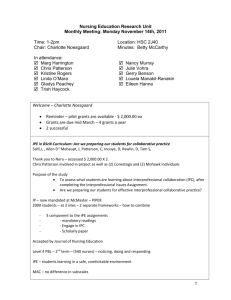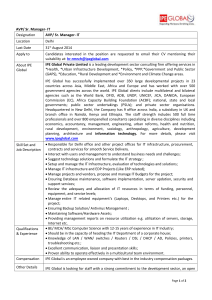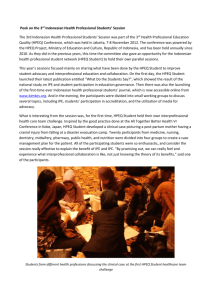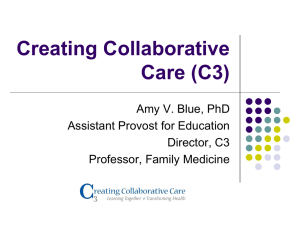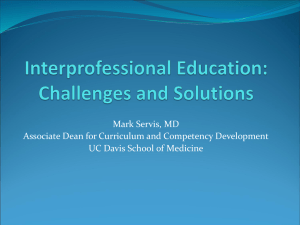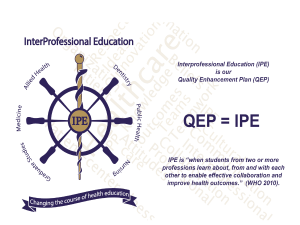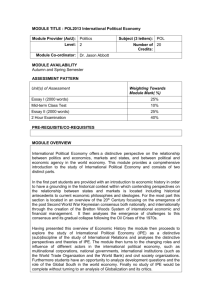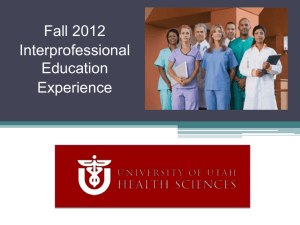Developing a Process for Faculty Development in Interprofessional
advertisement
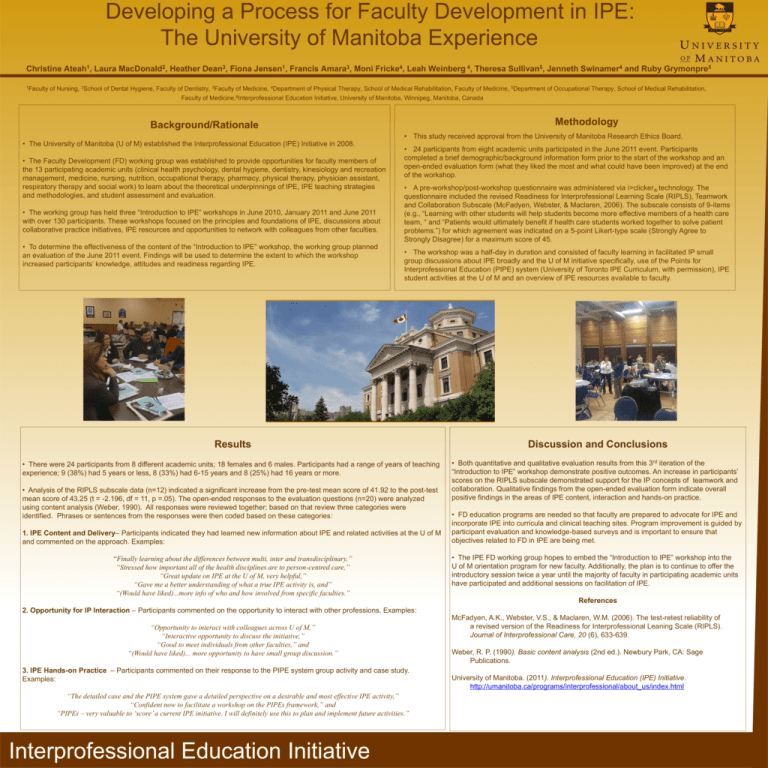
Developing a Process for Faculty Development in IPE: The University of Manitoba Experience Christine Ateah1, Laura MacDonald2, Heather Dean3, Fiona Jensen1, Francis Amara3, Moni Fricke4, Leah Weinberg 4, Theresa Sullivan5, Jenneth Swinamer4 and Ruby Grymonpre5 1Faculty of Nursing, 2School of Dental Hygiene, Faculty of Dentistry, 3Faculty of Medicine, 4Department of Physical Therapy, School of Medical Rehabilitation, Faculty of Medicine, 5Department of Occupational Therapy, School of Medical Rehabilitation, Faculty of Medicine,6Interprofessional Education Initiative, University of Manitoba, Winnipeg, Manitoba, Canada Methodology Background/Rationale • The University of Manitoba (U of M) established the Interprofessional Education (IPE) Initiative in 2008. • The Faculty Development (FD) working group was established to provide opportunities for faculty members of the 13 participating academic units (clinical health psychology, dental hygiene, dentistry, kinesiology and recreation management, medicine, nursing, nutrition, occupational therapy, pharmacy, physical therapy, physician assistant, respiratory therapy and social work) to learn about the theoretical underpinnings of IPE, IPE teaching strategies and methodologies, and student assessment and evaluation. • The working group has held three “Introduction to IPE” workshops in June 2010, January 2011 and June 2011 with over 130 participants. These workshops focused on the principles and foundations of IPE, discussions about collaborative practice initiatives, IPE resources and opportunities to network with colleagues from other faculties. • To determine the effectiveness of the content of the “Introduction to IPE” workshop, the working group planned an evaluation of the June 2011 event. Findings will be used to determine the extent to which the workshop increased participants’ knowledge, attitudes and readiness regarding IPE. • This study received approval from the University of Manitoba Research Ethics Board. • 24 participants from eight academic units participated in the June 2011 event. Participants completed a brief demographic/background information form prior to the start of the workshop and an open-ended evaluation form (what they liked the most and what could have been improved) at the end of the workshop. • A pre-workshop/post-workshop questionnaire was administered via i>clicker® technology. The questionnaire included the revised Readiness for Interprofessional Learning Scale (RIPLS), Teamwork and Collaboration Subscale (McFadyen, Webster, & Maclaren, 2006). The subscale consists of 9-items (e.g., “Learning with other students will help students become more effective members of a health care team, “ and “Patients would ultimately benefit if health care students worked together to solve patient problems.”) for which agreement was indicated on a 5-point Likert-type scale (Strongly Agree to Strongly Disagree) for a maximum score of 45. • The workshop was a half-day in duration and consisted of faculty learning in facilitated IP small group discussions about IPE broadly and the U of M initiative specifically, use of the Points for Interprofessional Education (PIPE) system (University of Toronto IPE Curriculum, with permission), IPE student activities at the U of M and an overview of IPE resources available to faculty. Results • There were 24 participants from 8 different academic units; 18 females and 6 males. Participants had a range of years of teaching experience; 9 (38%) had 5 years or less, 8 (33%) had 6-15 years and 8 (25%) had 16 years or more. • Analysis of the RIPLS subscale data (n=12) indicated a significant increase from the pre-test mean score of 41.92 to the post-test mean score of 43.25 (t = -2.196, df = 11, p =.05). The open-ended responses to the evaluation questions (n=20) were analyzed using content analysis (Weber, 1990). All responses were reviewed together; based on that review three categories were identified. Phrases or sentences from the responses were then coded based on these categories: 1. IPE Content and Delivery– Participants indicated they had learned new information about IPE and related activities at the U of M and commented on the approach. Examples: “Finally learning about the differences between multi, inter and transdisciplinary,” “Stressed how important all of the health disciplines are to person-centred care,” “Great update on IPE at the U of M, very helpful,” “Gave me a better understanding of what a true IPE activity is, and” “(Would have liked)...more info of who and how involved from specific faculties.” Discussion and Conclusions • Both quantitative and qualitative evaluation results from this 3rd iteration of the “Introduction to IPE” workshop demonstrate positive outcomes. An increase in participants’ scores on the RIPLS subscale demonstrated support for the IP concepts of teamwork and collaboration. Qualitative findings from the open-ended evaluation form indicate overall positive findings in the areas of IPE content, interaction and hands-on practice. • FD education programs are needed so that faculty are prepared to advocate for IPE and incorporate IPE into curricula and clinical teaching sites. Program improvement is guided by participant evaluation and knowledge-based surveys and is important to ensure that objectives related to FD in IPE are being met. • The IPE FD working group hopes to embed the “Introduction to IPE” workshop into the U of M orientation program for new faculty. Additionally, the plan is to continue to offer the introductory session twice a year until the majority of faculty in participating academic units have participated and additional sessions on facilitation of IPE. References 2. Opportunity for IP Interaction – Participants commented on the opportunity to interact with other professions. Examples: “Opportunity to interact with colleagues across U of M,” “Interactive opportunity to discuss the initiative,” “Good to meet individuals from other faculties,” and “(Would have liked)... more opportunity to have small group discussion.” 3. IPE Hands-on Practice – Participants commented on their response to the PIPE system group activity and case study. Examples: “The detailed case and the PIPE system gave a detailed perspective on a desirable and most effective IPE activity,” “Confident now to facilitate a workshop on the PIPEs framework,” and “PIPEs – very valuable to ‘score’ a current IPE initiative. I will definitely use this to plan and implement future activities.” Interprofessional Education Initiative McFadyen, A.K., Webster, V.S., & Maclaren, W.M. (2006). The test-retest reliability of a revised version of the Readiness for Interprofessional Leaning Scale (RIPLS). Journal of Interprofessional Care, 20 (6), 633-639. Weber, R. P. (1990). Basic content analysis (2nd ed.). Newbury Park, CA: Sage Publications. University of Manitoba. (2011). Interprofessional Education (IPE) Initiative. http://umanitoba.ca/programs/interprofessional/about_us/index.html
